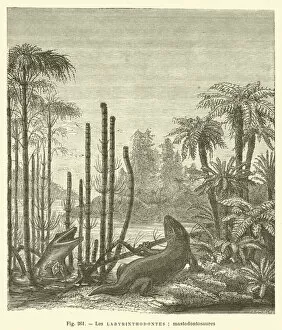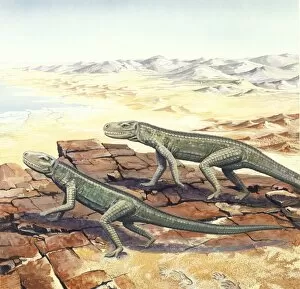Labyrinthodontia Collection
"Labyrinthodontia: Unraveling the Ancient Secrets of Prehistoric Amphibians" Step into the fascinating world of Labyrinthodontia
All Professionally Made to Order for Quick Shipping
"Labyrinthodontia: Unraveling the Ancient Secrets of Prehistoric Amphibians" Step into the fascinating world of Labyrinthodontia, a diverse group of prehistoric amphibians that once roamed the Earth millions of years ago. From Dicynodon to Labyrinthodon and Rhyncosaurus, these remarkable creatures captivate our imagination with their unique features and evolutionary significance. The term "Labyrinthodontia" refers to the complex tooth structure found in these ancient beings. As we delve deeper into their existence, we encounter Paracyclotosaurus davidi, a species known for its distinct model representation. The fossilized remains of this creature provide valuable insights into its anatomy and behavior. Amongst the labyrinthodonts, Les labyrinthodontes and mastodontosaures stand out as intriguing subjects depicted in engravings. These illustrations give us glimpses into what life may have been like during their time on Earth. One cannot ignore Eryops megacephalus - an impressive specimen boasting a massive head - which showcases the diversity within this group. Its model counterpart allows us to visualize how it might have appeared in its primeval habitat. Benthosuchus sushkini is another notable member that deserves recognition. With its unique characteristics, this species adds further complexity to our understanding of these ancient amphibians' evolution. As we piece together fragments from the past, it becomes evident that Labyrinthodontia played a significant role in shaping Earth's ecosystems during their reign. Their presence highlights an important transition from aquatic to terrestrial habitats for vertebrates. Today, thanks to extensive research and discoveries made by paleontologists worldwide, we can appreciate the intricate details preserved within fossils belonging to this extraordinary group. Through scientific exploration and analysis, we continue unraveling more about Labyrinthodontia's place in history while marveling at their resilience and adaptability throughout geological ages. Labyrinthodontia represents a captivating chapter in Earth's history.












